Published: 14 November 2018
People in the regions of Ostrobothnia marry youngest
According to Statistics Finland’s data on population changes, the average age at the time of first marriage was lowest in the four regions of Ostrobothnia for both women and men in 2017. In Central Ostrobothnia people entered into marriage at the youngest age, the average age for women was 29.7 years and for men 31.3 years. Of the regions in Mainland Finland, the average age of women at the time of first marriage was the highest in Lapland, 33.3 years. Correspondingly, the average age of men was highest in Kainuu, 36.1 years. In ┼land the men and women were even older at the time of first marriage than in Lapland and Kainuu, the average age for women was 36.8 years and for men 38.3 years. In the whole country, the average age at the time of first marriage was 31.7 years for women and 33.9 years for men.
Average age of women by first marriage and by region in 2017
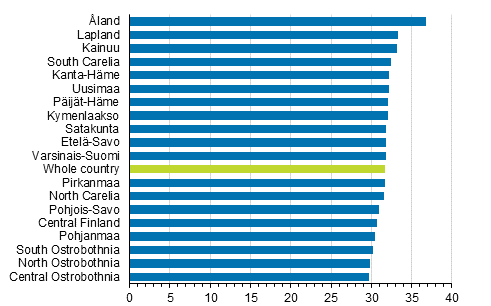
Opposite-sex couples.
Average age of men by first marriage and by region in 2017
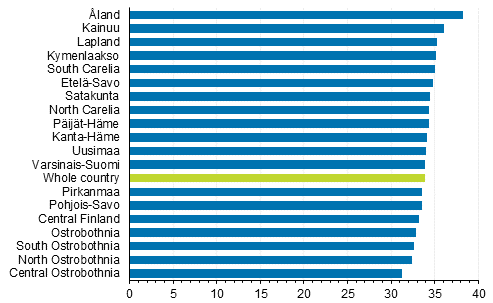
Opposite-sex couples.
In all regions the average age of men was higher than that of their spouses at the time of first marriage. The difference between the average ages is greatest in Kymenlaakso, 3.3 years. Correspondingly, the difference was smallest in Central Ostrobothnia and ┼land, 1.5 years in both. In the whole country the difference is 2.2 years. By region, the difference in lowest and highest age at the time of first marriage is seven years for both sexes.
From the beginning of the 1980s, the average age of persons entering into their first marriage between opposite sexes has risen from 25 to 32 years for women and for men from 27 to 34 years by 2017.
The trend of marriage rate declining
On the level of the whole country, the trend of marriage rate of opposite-sex couples has been declining already for over a decade. However, during the most recent years, the decline in marriage rate has slowed down. This is due to the remarriage rate remaining unchanged during the last three years. The figure shows the development of the remarriage and marriage rates for women as they are the same as for men. The figures calculated based on men are simply higher than those for women.
In 2017, the number of women and men getting remarried grew by a few dozen from the previous year, being 6,300 marriages for women and 6,500 for men. Over the past good ten years, the annual changes in the number of remarriages have been small measured by volume. After 2008, the remarriage rate decreased as did the marriage rate in general, but in recent years, the remarriage rate has picked up a bit, unlike the marriage rate.
Marriage rate╣ and remarriage▓ rate 1990–2016, opposite-sex couples
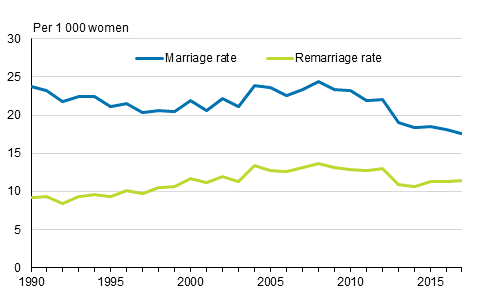
1. Married women per 1,000 non-married and women not in registered partnership of respective mean population aged 15 and over.
2. Remarried women per 1,000 previously married women of respective mean population.
First marriage can wait
Since the remarriage rate has not decreased, the decline in total marriage rate obviously is a result of the decrease in the first marriage rate. Since 2013, the share of women entering into their first marriage of all marriages between opposite sexes declined by two percentage points to 74 per cent, and correspondingly to 73 per cent for men. As already stated above, the average age for persons entering into their first marriage continues to rise, in other words, entering into marriage is delayed to an ever older age. This can clearly be seen in the development of marriage rates by age groups concerning first marriages: the marriage rate for those aged 20 to 34 has still declined in recent years. The development in marriage rate for these age groups pushes the total marriage rate to decline, too.
In 1990, seventy-four per cent of women who entered into first marriage were aged 20 to 34 and in 2017, the share was only 54 per cent. The development is similar for men in the same age group, the share decreased from 88 to 66 per cent.
In 1990, the share of women, who entered into their first marriage at the age of 35 or older, was six per cent of the first marriages entered into, and in 2017, the share had grown to 25 per cent. The corresponding share for men increased from 10 per cent to 34 per cent. These increasing shares can also be seen as increasing trends of marriage rates by age group concerning first marriages for persons aged 35 or older.
Even though the marriage rate for first marriages has been rising in relative terms considerably in older age groups, the number of marriages entered into is not high: 575 first marriages for women aged 50 to 64, which corresponds with three per cent of all first marriages entered into in 2017.
First marriage rate of woman by age 1990–2017, opposite-sex couples
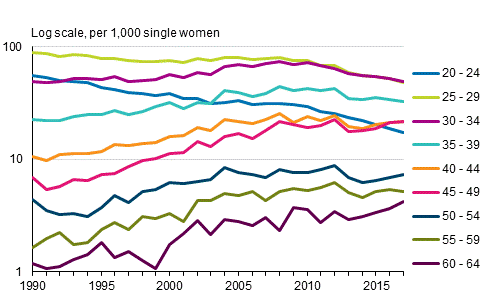
Finnish residents’ marriages more international than the year before
Women residing permanently in Finland married men representing 123 different nationalities in 2017, the year before the number was 120. The number of nationalities among the spouses can even be a bit higher than mentioned above, because nearly 130 persons had no nationality in 2017. In 1990, Finnish women married men representing 84 different nationalities. Nearly 40 spouses had no nationality data so the above-mentioned number can be slightly higher.
The number of nationalities of women to men permanently living in Finland has increased from 108 the year before to 120 in 2017. In addition, a small number of men’s spouses had no nationality, so the variation of nationalities can be slightly higher than mentioned above.
There are more data on marriages and divorces between Finnish and foreign citizens on the Immigrants and integration thematic pages .
Nearly four out of ten first marriages end in divorce
In 2017, the probability that a woman’s first marriage ends in divorce was 38 per cent. The rate is on level with that of the years 2005 to 2016, when it varied between 38 and 40 per cent. An interesting fact is that a first marriage ending in widowhood is slightly more probable than the marriage ending in divorce. The above-mentioned probabilities are based on the events of one year in the lives of opposite-sex married couples based on which the probability that an event takes place is calculated. In that case, e.g. the divorce rate can be summarised in one figure. Similar results can be reached by examining all marriages between opposite-sex spouses, entered into in a particular year that end in divorce, by the duration of the marriage, but in this case, there are as many divorce rates as years in which marriages are entered into.
Since the 1990s, the divorce rates by the duration of the marriage are very similar and are thus not dependent on the year in which the marriage was entered into. For example, one-fifth of the marriages entered into in 1990, 1995, 2000 and 2005 had ended in divorce in nine years and one-quarter in 12 years, except for marriages entered into in 2005 for which this already happened in 11 years. The divorce rate for marriages entered into in 2015 does not appear to differ from the development of divorce rate for the above mentioned years.
Divorce rates cumulated for women entering into marriage in certain years by the end of 2017, opposite-sex couples
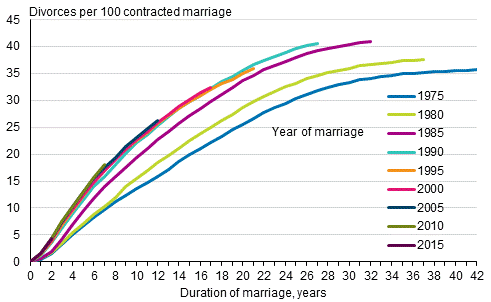
The share of divorces has long been largest among those who entered into marriage in 1985, but a share some tenths larger among marriages entered into in 1989 had ended in divorce by the end of 2017. Of the marriages entered into in 1989, 41.3 per cent had ended in divorce by the end of 2017, while the corresponding number for marriages entered into in 1985 was 41.0 per cent. Persons who have entered into marriages during the years close to the years mentioned above also end up with a divorce percentage share of 40 per cent: 1983 to 1984, 1986 to 1988 and 1990 to 1991. If the divorce rate remains at the level where it has been for a long time, it is highly possible that the other marriage cohorts of the 1980s and those of the 1990s will reach the same divorce rate level as those who entered into marriage in 1985 and 1989.
The risk of divorce grows steeply during the first years of marriage. The risk is highest in the third year. After the peak for divorcing is reached, the risk of divorce decreases very similarly in all marriage cohorts.
Divorces by year entering into marriage and duration of marriage, women, opposite-sex couples
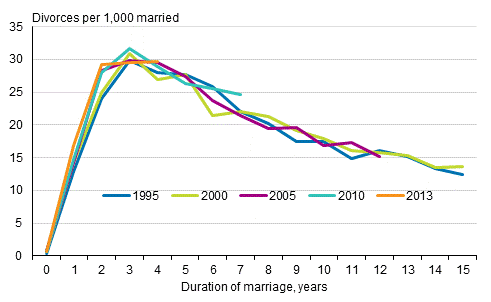
From registered partnerships to entering into marriage
Due to the amendment to the Marriage Act that entered into force at the beginning of March 2017, same-sex couples enter into marriage and partnerships are no longer registered. Prior to the Act entering into force, by the end of February, 21 male couples and 15 female couples still registered their partnership. From the beginning of March to the end of the year, 554 same-sex couples entered into marriage, 181 male couples and 373 female couples.
Prior to the amendment to the Act, the number of registered partnerships had decreased in 2016 to the same level as in 2008 to 2009. After the amendment a record number of marriages were entered into, when compared to the annual number of registered partnerships. Of all marriages entered into, 60 per cent were marriages where both same-sex spouses were unmarried in 2017.
Registered partnerships 2002–2016 and registered partnerships and contracted same-sex marriages 2017
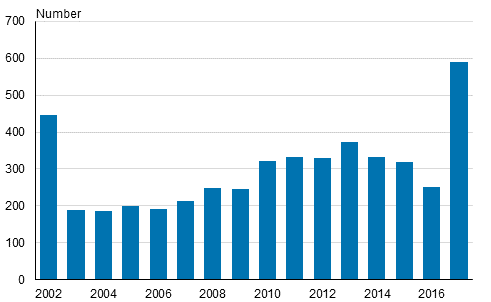
Divorce rate of same-sex couples almost unchanged
In 2017, the changes in divorce rate were small for both opposite-sex and same-sex couples. The divorce rate for same-sex couples was 21 per one thousand couples, while it was 22 the previous year. Correspondingly, the divorce rate for opposite-sex couples was 13 per one thousand couples, while it was 14 the previous year.
There has been a clear difference in the divorce rates of male and female couples as female couples’ divorce rate has been clearly higher than that of male couples since 2004. In 2017 the divorce rate of male couples decreased a little, while the divorce rate of female couples increased. In the longer term, the trend of the divorce rate is slightly growing for same-sex couples, while the divorce rate for opposite-sex couples has remained almost unchanged.
Divorce rates from opposite-sex and same-sex╣ couples 2003–2017
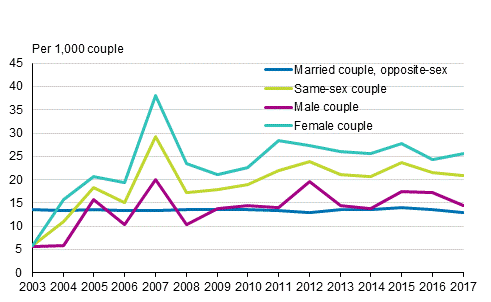
1. Divorces from registered partnerships 2003–2016. Year 2017 also includes divorces from same-sex marriages.
Source: Changes in marital status 2017. Statistics Finland
Inquiries: Timo Nikander 029 551 3250, info@stat.fi
Director in charge: Jari Tarkoma
Publication in pdf-format (371.7 kB)
- Tables
-
Tables in databases
Pick the data you need into tables, view the data as graphs, or download the data for your use.
Appendix tables
- Appendix table 1. First marriage rate by age and total period first marriage rate╣ 2006 to 2017, opposite-sex couples (14.11.2018)
- Appendix table 2. Newly married women by age and age of spouse 2017, opposite-sex couples (14.11.2018)
- Appendix table 3. Marriage rate▓ by region in 2006 to 2017, opposite-sex couples (14.11.2018)
- Appendix table 4. Divorces by age of spouses 2017, opposite-sex couples (14.11.2018)
- Appendix table 5. Divorces by age of mother and children aged under 18 in 2017, opposite-sex couples (14.11.2018)
- Quality descriptions
-
- Quality description, changes in marital status (14.11.2018)
Updated 14.11.2018
Official Statistics of Finland (OSF):
Changes in marital status [e-publication].
ISSN=1797-643X. 02 2017. Helsinki: Statistics Finland [referred: 14.12.2025].
Access method: http://stat.fi/til/ssaaty/2017/02/ssaaty_2017_02_2018-11-14_tie_001_en.html

